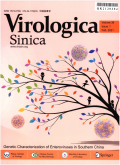Continued antigenic variation of highly pathogenic avian influenza A(H7N9)virus in laying hens in China,2020-2021
Dear Editor,
Since it first appeared in humans in China in 2013,a novel H7N9 influenza virus has caused 1,568 cases of infection,with a mortality rate of 39.2%(Yin et al.,2021).The early H7N9 virus strains had low path-ogenicity and did not cause avian disease(Zhang et al.,2013).However,they caused concern about poultry consumption and caused huge eco-nomic losses to the poultry industry.Since mid-2016,some H7N9 viruses mutated,with an insertion of four basic amino acids in their cleavage sites of hemagglutinin(HA)and thereby became highly pathogenic to chickens,causing multiple outbreaks in poultry in China(Wang et al.,2017;Hou et al.,2019).
variation、china、virus、antigenic、avian、continued、hens、highly、influenza、laying
37
S;S435.131.4;F752.7
2023-05-15(万方平台首次上网日期,不代表论文的发表时间)
共3页
631-633






